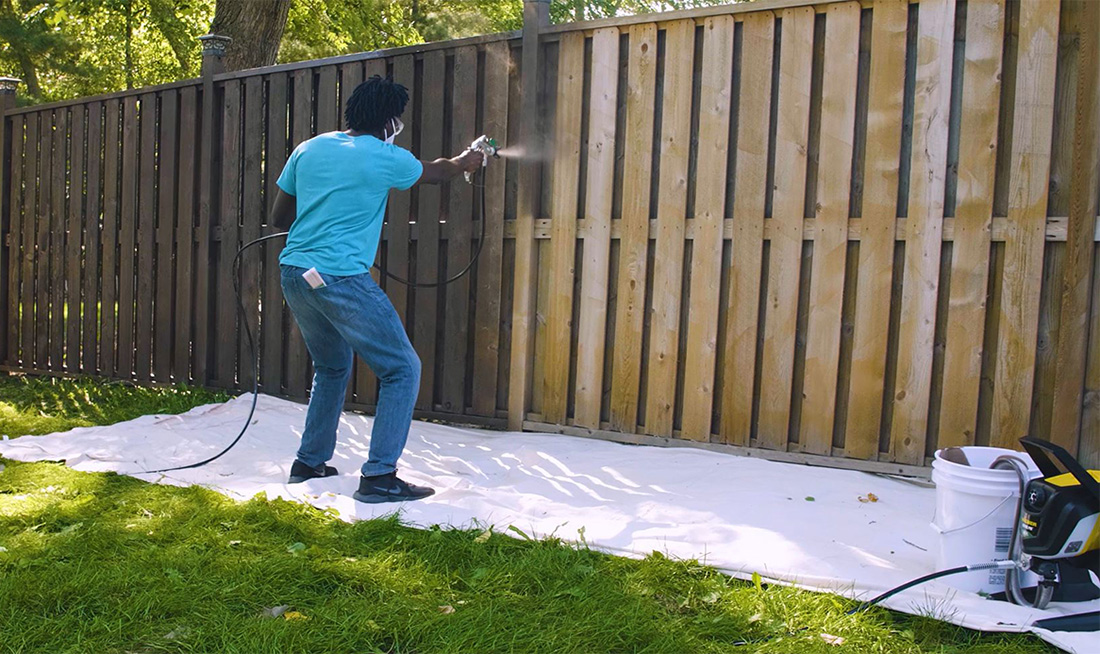Renew Your Fence's Look with High quality Fence Staining!
Renew Your Fence's Look with High quality Fence Staining!
Blog Article
Fencing Staining 101: Everything You Required to Know for a Spectacular End Up
When it pertains to enhancing the visual charm and lengthening the lifespan of your fence, staining is an essential element that requires focus to information. The procedure of fence staining includes greater than simply picking a color and applying it carelessly. From selecting the best kind of discolor to meticulously preparing the surface and carrying out the application technique, every action plays a significant function in accomplishing a perfect coating. By recognizing the principles of fence discoloration, you can raise the appearance of your outdoor space and guarantee the defense of your fence versus numerous components.
Choosing the Right Spot
Selecting an appropriate discolor for your fencing is crucial in protecting its longevity and improving its visual allure. When picking the right discolor, there are numerous elements to consider. Figure out the kind of wood your fencing is made of, as different wood varieties react in a different way to numerous discolorations. Cedar may need a various kind of stain contrasted to yearn. Next off, think about the wanted appearance you want to accomplish. If you prefer a more natural look that permits the timber grain to show through, a clear or semi-transparent tarnish would appropriate. Nevertheless, if you desire to include shade or hide imperfections in the wood, a solid stain may be the far better option. It is additionally necessary to think of the degree of maintenance you are eager to commit to. Some stains might need more frequent reapplication than others, so pick a stain that aligns with your upkeep choices. By taking these elements right into account, you can choose a stain that not just protects your fence yet likewise improves its total appearance.
Preparing Your Fencing
Prior to applying the chosen discolor to your fence, it is essential to sufficiently prepare the surface to make certain optimal outcomes and durability. The very first action in preparing your fencing is to clean it extensively.
Fining sand the fence is the following critical step to make sure a smooth surface for the tarnish to adhere to. Make use of a medium-grit sandpaper to get rid of any harsh spots or old tarnish that may be peeling off.
Last but not least, secure any type of locations you don't want to stain by using painter's tape and plastic sheet - Fence Staining Service - Fence Staining. This will certainly make certain clean lines and prevent unintended staining of various other surfaces. Properly preparing your fencing will certainly not just enhance the last appearance but additionally add to the long life of the tarnish

Using the Spot
To accomplish an expert surface when staining your fence, make certain that you apply the tarnish in even strokes complying with the wood grain direction. This strategy aids the discolor permeate the wood uniformly, causing a consistent appearance. Prior to starting, drink or mix the discolor thoroughly to blend any kind of worked out pigments. Begin by pouring a percentage of tarnish into a paint tray. Using a high-quality brush or a paint sprayer, start applying the discolor from the top of the fencing, functioning your way to stop drips. Make certain to overlap each stroke a little to prevent missed out on spots.
Operate in convenient areas to preserve a wet side and avoid lap marks. If utilizing several containers of discolor, blend them together to guarantee color uniformity. Watch out for any type of drips or runs and smooth them out instantly. After finishing the whole fencing, allow adequate drying time as per the supplier's guidelines before applying a 2nd coat if preferred. Appropriate application is vital to attaining an attractive and resilient coating on your fencing.
Tips for a Professional Finish
Accomplishing a professional coating on your tarnished fencing requires thorough attention to detail and adherence to ideal practices in application methods. Tidy the fencing of any kind of dirt, particles, or old tarnish utilizing a pressure washer or a stiff brush and soapy water. Select a top notch tarnish that is ideal for your fencing type and environment problems.
When it comes to applying the discolor, use a brush, roller, or sprayer for an even and constant coat. Permit the stain to completely dry completely according to the producer's instructions prior to taking into consideration a 2nd layer.
Maintenance and Treatment
Making sure regular upkeep and proper treatment of your discolored fencing is necessary for preserving its look and architectural stability over time. To keep the magnificent a fantastic read finish accomplished with discoloration, it is suggested to inspect the fencing at the very least annually for any kind of indicators of wear, damages, or staining. Resolving issues immediately can prevent them from rising and requiring more extensive fixings.
Regular upkeep tasks include cleaning up the fencing with a light cleaning agent and water to remove dust, gunk, and mildew that can collect over time. Additionally, trimming any plant life that enters into contact with the fence can stop damages from overgrowth. Evaluate the tarnish for signs of fading or wearing off, and take into consideration using a maintenance layer every 2-3 years to maintain the fencing looking fresh and vivid.
Appropriate care also involves protecting the tarnished fence from severe elements by considering factors such as sun direct exposure, wetness, and temperature level fluctuations - Fence Staining. Using a safety sealer can better improve the longevity of the tarnish and shield the timber from environmental damage. By adhering to these maintenance methods, you can ensure that your stained fencing remains a gorgeous and sturdy property to your home for several years ahead
Final Thought

Report this page